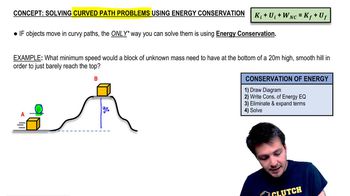Motion Along Curved Paths definitions Flashcards
 Back
BackMotion Along Curved Paths definitions
1/15
Terms in this set (15)
- Curved Path ProblemA scenario where an object moves along a path with a constantly changing slope angle, complicating force and kinematic analysis.
- Energy ConservationA principle stating that the total energy in a closed system remains constant, used to solve problems with non-constant acceleration.
- Kinetic EnergyThe energy an object possesses due to its motion, calculated as 1/2 times mass times velocity squared.
- Potential EnergyThe energy stored in an object due to its position in a gravitational field, calculated as mass times gravity times height.
- Non-conservative ForcesForces that cause energy dissipation from a system, such as friction, not present in the given problem.
- Gravitational Potential EnergyEnergy an object possesses due to its height above a reference point, contributing to total mechanical energy.
- Minimum SpeedThe lowest velocity required for an object to reach a certain point without falling short.
- Acceleration due to GravityThe constant rate at which objects accelerate towards Earth, approximately 9.8 m/s².
- Hill HeightThe vertical distance from the base to the top of a hill, given as 20 meters in the problem.
- Initial ConditionsThe starting parameters of a problem, including initial kinetic energy and zero potential energy at the base.
- Final ConditionsThe parameters at the end of a problem, including zero kinetic energy and maximum potential energy at the hill's peak.
- VelocityThe speed of an object in a specific direction, crucial for determining kinetic energy.
- Mass CancellationA simplification in energy equations where mass is eliminated from both sides, focusing on velocity and height.
- Square Root CalculationA mathematical operation used to solve for velocity in energy equations, involving the square root of 2g times height.
- Smooth HillA surface with no friction, ensuring no work is done by non-conservative forces in the problem.

